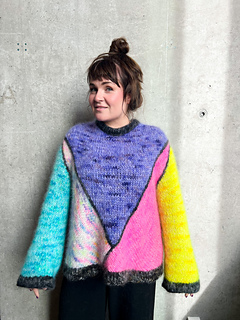patterns >  Inga Semmingsen's Ravelry Store
Inga Semmingsen's Ravelry Store
> Nybrua






Nybrua
Nybrua is knitted piece by piece by picking up stitches and knitting the parts in different directions. The only seams are along the sides of the body. It has a deep yoke and can resemble a swoncho. It will rise when you lift your arms. You can knit it in the suggested fluffy mohair and blow-yarn or combine leftover yarn to create a completely unique version that mixes qualities and colors you like.
Sizes: XS (S) M (L) XL (2XL) 3XL (4XL)
Measurements after blocking:
Breast circumference: 98 (109) 113 (119) 124 (132) 140 (146) cm/ 38.5 (43) 44.5 (47) 49 (52) 55 (57.5)
Sleeve circumference: 33 (35) 38 (40) 43 (45) 49 (51) cm/ 13 (14) 15 (16) 17 (18) 19 (20) inches
Choose a size that is 10 to 30 cm/4 to 12 inches larger than your own chest measurement.
Gauge: 11 x 14 sts on 10x10 cm after blocking
Suggested needles:
8 mm (US 11) main needle
7 mm (US 10.5) rib needle.
Yarn:
Tjukk Mohair from Strikkefeber (100 m = 50 g) held together with Sandnes Kos (150 m = 50 g)
Yarn quantity:
Color A:
Mohair: 50 (100) 100 (100) 100 (100) 100 (100) g
Kos: 50 (50) 50 (50) 100 (100) 100 (100) g
Color B:
Mohair: 50 (50) 50 (50) 100 (100) 100 (100) g
Kos: 50 (50) 50 (50) 50 (50) 100 (100) g
Color C:
Mohair: 50 (50) 50 (100) 100 (100) 100 (100) g
Kos: 50 (50) 50 (50) 50 (100) 100 (100) g
Color D og E:
Mohair: 50 (50) 50 (50) 100 (100) 100 (100) g
Kos: 50 (50) 50 (50) 50 (100) 100 (100) g
Contrast color X (ribbing and contrast stripes):
Mohair: 50 (50) 50 (100) 100 (100) 100 (100) g
Kos: 50 (50) 50 (50) 50 (100) 100 (100) g
Scrap yarn version:
Start with a thread of thick mohair (e.g. Rauma thick mohair, hand-dyed fat mohair, etc.) combined with a thread of blow yarn with around 150 m per 50 g (e.g. Sandnes Kos, Jord fluff, Järbo llama soft, etc.) and knit a test swatch with 8 mm needles. Wash it and measure the width. It should be about 11 stitches over 10 cm after blocking. If you have fewer stitches, you should use smaller needles. If you have more stitches, you should use larger needles. Once you have found the right gauge, you have your base thickness and needle.
Now, divide your leftover yarn by colors into 6 piles. Decide which one will be the contrast color (the stripes that separate the different colors). Each time you change colors, combine yarns to achieve the correct thickness.
If you wish, you can divide your yarn into 8 colors and use the two extra on the right and left back piece. It is also possible to knit stripes on some of the parts for an extra cool effect.
NB! Make sure to have a loose stitch pattern so the sweater doesn’t become too heavy. Cotton, linen, and tightly spun yarn add a lot of weight and can result in the sweater sagging. Combinations with airy and/or fluffy yarn are a sure winner.
4080 projects
stashed
2127 times
5 projects
stashed
2 times
- First published: October 2023
- Page created: October 16, 2023
- Last updated: December 15, 2023 …
- visits in the last 24 hours
- visitors right now




